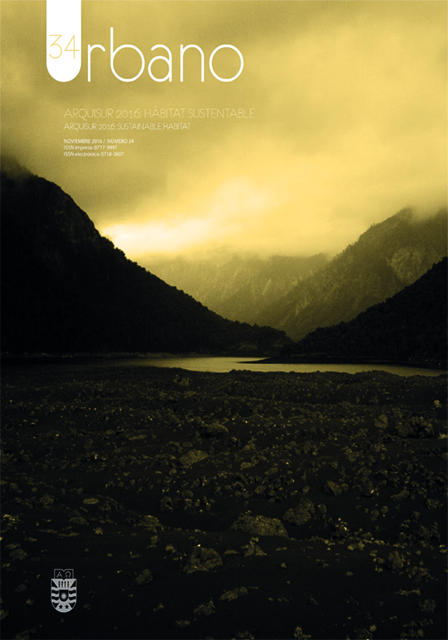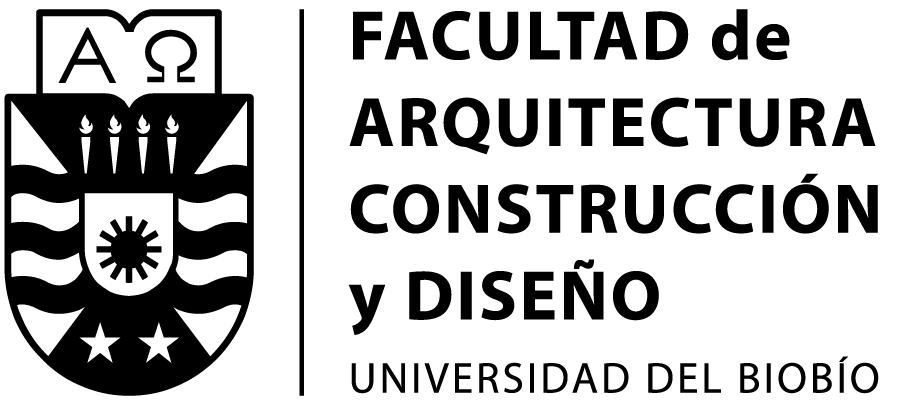Factor de cielo visible y el efecto de isla de calor en Valparaíso
DOI:
https://doi.org/10.22320/07183607.2016.19.34.3Palabras clave:
Isla de Calor, Morfología Urbana, Clima, Planificación Urbana, Morfología Urbana, Trama Urbana, Planificación UrbanaResumen
La forma urbana transforma el territorio y su comportamiento climático. La morfología de la ciudad varía desde sus centros hasta su periferia, así como también varía en densidad poblacional, en el uso temporal de las edi caciones, en la presencia o ausencia de vegetación o en la densidad de transporte. Estas variables condicionan el comportamiento térmico del espacio público. A partir de la consideración de la visibilidad del cielo desde el cañón urbano se de ne el SVF (Sky View Factor), que está relacionado con el almacenamiento térmico y la ventilación del espacio de la calle. Ambas variables son fundamentales en el confort peatonal y en el calentamiento de la ciudad. En este trabajo se presentan desempeños climáticos asociados a la morfología de la ciudad de Valparaíso, ubicada en un clima mediterráneo costero. Se realizaron mediciones climáticas simultáneas en diversos lugares de la ciudad que se correlacionaron con parámetros geométricos y materiales de los lugares registrados. Se determina una estrecha relación entre morfología urbana, comportamiento térmico del espacio público y aumento de la temperatura favoreciendo el fenómeno de isla de calor (UHI). Estos valores permitirían predecir en forma más precisa las condiciones climáticas en el nivel de calle y la manera cómo afecta en el fenómeno urbano de isla de calor (UHI).
Descargas
Citas
Akbari, H., & Konopacki, S. (2005). Calculating energy-saving potentials of heat-island reduction strategies. Energy Policy, 33(6), 721–756.
Ali-Toudert F. & Mayer H., Numerical study on the effects of aspect ratio and solar orientation on outdoor thermal comfort in hot and dry climate, Building and Environment, 41 (2006), pp. 94–108.
Ashtiani, A.; Mirzaei, P. A. & Haghighat, F. (2014), Indoor thermal condition in urban heat island: Comparison of the artificial neural network and regression methods prediction, Energy and Buildings 7, 597-604.
Blennow, K. (1995) Sky view factors from high resolution scanned fish-eye lens photographic negatives. Journal of Atmospheric and Oceanic Technology 12. pp1357-1362.
Bozonnet E., R. Belarbi and F. Allard, (2006) Modelling air flows around buildings in urban environment, International Workshop on EPEQUBE, Milos Island, Greece, July, 2006.
Brewer-Carías Allan R. La ciudad ordenada. Instituto Pascal Madoz. Universidad Carlos III. Boletin Oficial del Estado. Madrid 1997.
Busato F, Lazzarin R.M. & Noro M. (2014) Three years of study of the Urban Heat Island in Padua: Experimental results. Department of Management and Engineering, University of Padova, Sustainable Cities and Society, 10, 251–258.
Carrasco C. (2014) Analysis of urban heat island and its effects in Valparaíso, Chile. Presentado en la conferencia IC2UHI, Venecia, diciembre 2014.
Cleugh, H.A. & Oke, T.R. (1986). “Suburban-rural energy balance comparisons in summer for Vancouver, B.C.”. Boundary Layer Meteorology, 36, pp. 351-369.
Christen A., Vogt R., Rotach M.W., Parlow E. (2002a). First Results from BUBBLE I: Profiles of fluxes in the urban roughness sublayer. AMS 4th Symposium on the Urban Environment, Norfolk VA. 105-106.
Christen A., Vogt R., Rotach M.W., Parlow E. (2002b). First Results from BUBBLE II: Partitioning of turbulent heat fluxes over urban surfaces. AMS 4th Symposium on the Urban Environment, Norfolk VA. 137-138.
Davis R. E., Knappenberger P. C., Michaels P. J. & Novicoff W. M. Wave mortality in large U.S. cities. Fifth Conference on Urban Environment. Vancouver, BC. August 2004.
Gal T., Lindberg F. & Unger1 J. (2009) Computing continuous sky view factors using 3D urban raster and vector databases: comparison and application to urban climate. Theoretical and Applied Climatology. 95: 111–123.
Grimmond C.S.B., Potter S.K., Zutter H.N. & Souch C. (2001) Rapid methods to estimate sky- view factors applied to urban areas. International Journal of Climatology 21: 903–913.
Grimmond C. S. B. & Oke, T. R., (1999) Heat storage in urban areas: observations and evaluation of a simple model, Journal of Applied Meteorology 38 pp. 922-940.
Grimmond C. S. B. & Oke, T. R. Comparison of heat fluxes from summertime observations in the suburbs of tour Nort American cities. Journal of Applied Meteorology (1995) Vol. 34, pp. 873-889.
Isalgué, A. Roset J. & Coch, H.. Environmental Evaluation of an Urban Sector. REBUILD: The European Cities of Tomorrow - Shaping our European Cities for the 21st Century. Butera, et al (ed.), ETA-Florence, 1998.
Kikegawa Y., Ohashi Y. & Kondo H. Observed and simulated effects of urban canopy on air temperatures in summer Tokyo. 7th Conference on Urban Environment. San Diego, CA. September 2007.
Kolokotronia M., Rena X., Daviesb M., Mavrogianni A. (2012) London’s urban heat island: Impact on current and future energy consumption in office buildings. Energy and Buildings 47, 302–311.
Ratti C., Baker N. & Steemers K. Energy consumption and urban texture. Energy and Buildings Vol 37. pp. 762 - 776 (2005).
Roth, M. & Oke T.R., (1995) Relative efficiencies of turbulent transfer of heat, mass and momentum over a patchy urban surface. Journal of the Atmospheric Sciences, 52, 1863-1874.
Santamouris, M., Argirious, A. & Papanikolaou, N. (1996). Meteorological Stations for Microclimatic Measurements. Report en Proyecto POLIS. Comisión Unión Europea, 1996.
Souza, L. C. L.; Rodrigues, D.; Mendes, G. & J. F. A 3D-gis extension for sky view factors assesment in urban environment. In: CUPUM 2003 - 8th International Conference on Computers in Urban Planning and Urban Management, 2003, Sendai. CUPUM'03 Sendai, 2003.
Susca, T., Gaffin, S. R., & Dell’Osso, G. R. (2011). Positive effects of vegetation:Urban heat island and green roofs. Environmental Pollution, 159(8–9), 2119–2126.
Takebayashi, H., & Masakazu, M. (2007). Surface heat budget on green roof and highreflection roof for mitigation of urban heat island. Buildings and Environment,42 (8), 2971–2979.
United Nations. (2010). World urbanization prospects: The 2014 revision population database. https://esa.un.org/unpd/wup/
Voogt J. A. & Krayenhoff E. S.. Modeling urban thermal anisotropy. International Society OF Photogrammetry and Remote Sensing. Proceedings of the ISPRS joint conference. Tempe, AZ, USA, March 14-16 2005.
Descargas
Publicado
Cómo citar
Número
Sección
Licencia
Derechos de autor 2016 Claudio Carrasco, Massimo Palme, Miguel Angel Galvez

Esta obra está bajo una licencia internacional Creative Commons Atribución-CompartirIgual 4.0.
El contenido de los artículos y reseñas que se publican en cada número de Urbano, es responsabilidad exclusiva de los autores y no representan necesariamente el pensamiento ni comprometen la opinión de la Universidad del Bío-Bío.
Las/os autoras/es conservarán sus derechos de autor, sin embargo, garantizarán a la revista el derecho de primera publicación y difusión de su obra. La publicación del artículo en Urbano estará sujeta a la Licencia de Reconocimiento de Creative Commons CC BY-SA que permite a otros compartir-copiar, transformar o crear nuevo material a partir de esta obra para cualquier propósito, incluso comercialmente, siempre y cuando se reconozcan la autoría y la primera publicación en esta revista, y sus nuevas creaciones estén bajo una licencia con los mismos términos.![]()























